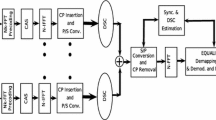Abstract
The uplink of orthogonal frequency division multiple access or single-carrier frequency division multiple access suffers multiple access interference when carrier frequency offset (CFO) is not properly estimated and compensated. In particular, multicarrier uplink CFO compensation is highly complex due to the multiuser context. Successive interference cancellation algorithms are effectively employed to compensate for the CFO, where the interference produced by each user is handled sequentially through a series of iterations. The main contribution of this work is the analysis of the CFO compensation performance of efficient successive cancellation algorithms. We study the mean square symbol error, and derive a useful upper-bound of the compensation technique performance at convergence. This result extends the general convergence results for the space-alternating generalized expectation-maximization algorithm in the CFO compensation scenario. Finally, we validate the analysis with numerical simulations.




Similar content being viewed by others
Notes
If \(\xi ^{(1)}=0.5\), the worst case results \(C_{sum}=N_t-2\).
References
Holma, H., & Toskala, A. (2009). LTE for UMTS–OFDMA and SC-FDMA based radio access (1st ed.). New York: Wiley.
3rd generation partnership project (3GPP) technical specification group radio access network; physical layer aspects for evolved universal terrestrial radio access (UTRA) (release 7). 3GPP TR 25.814, V7.1.0 (Sept. 2006).
Pun, M.-O., Morelli, M., & Jay Kuo, C. C. (2007). Multi-carrier techniques for broadband wireless communications: A signal processing perspectives. London: Imperial College Press.
Nguyen, H., de Carvalho, E., & Prasad, R. (2010). Joint estimation of the timing and frequency offset for uplink OFDMA. Wireless Personal Communications, 52(1), 119–131.
Lee, K., Moon, S.-H.-, Lee, S.-R., & Lee, I. (2012). Low complexity pilot assisted carrier frequency offset estimation for OFDMA uplink systems. IEEE Transactions on Wireless Communications, 11(8), 2690–2695.
An, C., & Ryu, H.-G. (2015). A novel CFO suppression algorithm for OFDMA uplink communication system. Wireless Personal Communications, 80(1), 357–368.
Hsu, C.-Y., & Wu, W.-R. (2008). A low-complexity zero-forcing CFO compensation scheme for OFDMA uplink systems. IEEE Trans. Wireless Commun., 7(10), 3657–3661.
Lee, K., Lee, S.-R., Moon, S.-H.-, & Lee, I. (2012). MMSE-based CFO compensation for uplink OFDMA systems with conjugate gradient. IEEE Transactions on Wireless Communications, 11(8), 2767–2775.
Fessler, J. A., & Hero, A. O. (1994). Space-alternating generalized expectation-maximization algorithm. IEEE Transactions on Signal Processing, 42(10), 2664–2677.
Bai, L., & Yin, Q. (2012). Frequency synchronization for the OFDMA uplink based on the tile structure of IEEE 802.16e. IEEE Transactions on Vehicular Technology, 61(5), 2348–2353.
Dempster, A. P., Laird, N. M., & Rubin, D. B. (1977). Maximum likelihood from incomplete data via the EM algorithm. Journal of the Royal Statistical Society, Series B, 39(1), 1–38.
Dahlman, E., Parkvall, S., Sköld, J., & Beming, P. (2008). 3G evolution HSPA and LTE for mobile broadband (2nd ed.). Amsterdam: Elsevier.
IEEE standard for local and metropolitan area networks part 16: Air interface for fixed broadband wireless access systems. In IEEE Std 802.16-2004 (Revision of IEEE Std 802.16-2001) (pp. 01–857) (2004).
Barbarossa, S., Pompili, M., & Giannakis, G. B. (2002). Channel-independent synchronization of orthogonal frequency division multiple access systems. IEEE Journal on Selected Areas in Communications, 20(2), 474–486.
Cao, Z., Tureli, U., & Yao, Y.-D. (2007). Low-complexity orthogonal spectral signal construction for generalized OFDMA uplink with frequency synchronization errors. IEEE Transactions on Vehicular Technology, 56(3), 1143–1154.
ITU-R. (1997). Guidelines for evaluation of radio transmission technologies for IMT-2000. In Recommendation ITUR M1225 (Vol. 93, no. 3, pp. 148–56).
LTE. (July 2012). Evolved universal terrestrial radio access (E-UTRA); base station (BS) radio transmission and reception.
Author information
Authors and Affiliations
Corresponding author
Appendices
Appendix 1: Proof of Lemma 1
Proof
By replacing \({\hat{\mathbf{s}}}_{q+1}\) by (10), we can rewrite (11) as
Note that \({{\varvec{\Psi }}}^{|q+1|_K}\) is not necessary due to the selection operation \([\cdot ]_n\).
Since the noise is independent of the transmitted data and has zero mean, (21) can be written as in the following expression
Using the Cauchy–Schwarz inequality in (22), the equation can be rewritten as
By defining
(first column of \({\varvec{A}}(l,q+1)\)) and considering n is allocated to user \(|q+1|_K\), we can express the circular matrix multiplication of (23) as the following circular convolution
As the energy of the interference is located close to n, we consider only \(N_h\) carriers adjacent to n, where \(N_h\) is chosen to consider more than 99.9 % of the interference energy. Then, applying again the Cauchy–Schwarz inequality and assuming that the CFO is deterministic and unknown, and n is allocated to user \(|q+1|_K\), (26) can be rewritten as
where it is used that \(\text {E}\left\{ |e_l(n)|^2\right\} = [\mathbf{m}_l]_{n}\). If we define the \(N_c\times N_c\) banded convolution matrix \(\mathbf{C}_{l,q+1}\), with elements
the MSE as a function of the previous iterations results
\(\square\)
Appendix 2: Maximum Value of C sum
The maximum value of \(C_{sum}\) is produced by a system with ICAS, where contiguous tiles belong to users with opposed CFO values, i.e. \(\xi ^{(m_1)}=-\xi ^{(m_2)}\), if \(m_1\) and \(m_2\) are contiguous users. On the other hand, the maximum value of CFO that results in full-rank \({\varvec{\varPhi }}\) matrices is \(|\xi ^{(m)}|<0.5\) [15].
Considering the worst case \(|\xi ^{(m)}|=0.5\), and that \(\xi ^{(1)}=-0.5\) (the CFO of the user allocated in the first tile is -0.5),Footnote 1 the matrix \({\bar{\mathbf{C}}}\) has the following structure
where the only non zero matrices are \({\tilde{\mathbf{C}}}_a = {\tilde{\mathbf{C}}}_{1,0} = {\tilde{\mathbf{C}}}_{3,2} = \cdots = {\tilde{\mathbf{C}}}_{N_t-1,N_t-2}\) and \({\tilde{\mathbf{C}}}_b = {\tilde{\mathbf{C}}}_{0,1} = \tilde{\mathbf{C}}_{2,3} = \cdots = {\tilde{\mathbf{C}}}_{N_t-2,N_t-1}\), with dimension \(L_t\times L_t\) ; and values
As in each column or row of (30) there is either one \({\tilde{\mathbf{C}}}_a\) or one \({\tilde{\mathbf{C}}}_b\), it is easy to see that the worst-case value results \(C_{sum}=KN_t\).
Rights and permissions
About this article
Cite this article
González, G.J., Gregorio, F.H., Cousseau, J.E. et al. Analysis of the CFO Successive Interference Cancellation for the OFDMA Uplink. Wireless Pers Commun 91, 989–1002 (2016). https://doi.org/10.1007/s11277-016-3509-0
Published:
Issue Date:
DOI: https://doi.org/10.1007/s11277-016-3509-0




